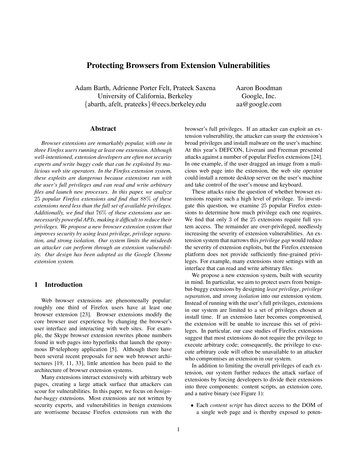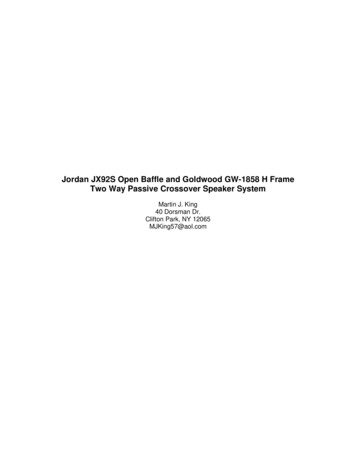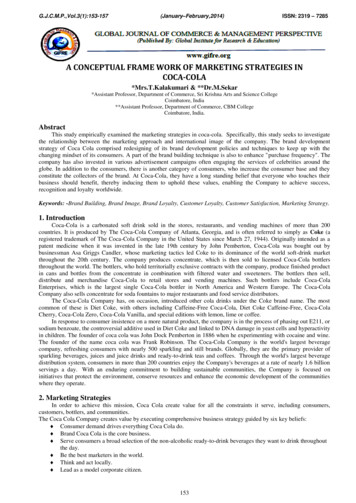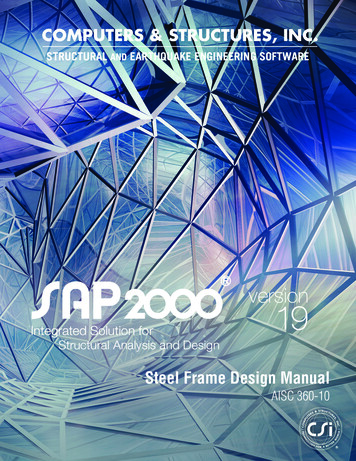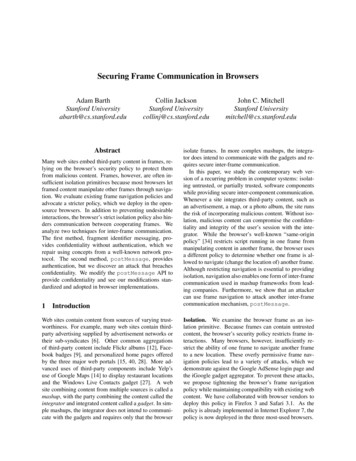
Transcription
Securing Frame Communication in BrowsersAdam BarthStanford Universityabarth@cs.stanford.eduCollin JacksonStanford Universitycollinj@cs.stanford.eduAbstractMany web sites embed third-party content in frames, relying on the browser’s security policy to protect themfrom malicious content. Frames, however, are often insufficient isolation primitives because most browsers letframed content manipulate other frames through navigation. We evaluate existing frame navigation policies andadvocate a stricter policy, which we deploy in the opensource browsers. In addition to preventing undesirableinteractions, the browser’s strict isolation policy also hinders communication between cooperating frames. Weanalyze two techniques for inter-frame communication.The first method, fragment identifier messaging, provides confidentiality without authentication, which werepair using concepts from a well-known network protocol. The second method, postMessage, providesauthentication, but we discover an attack that breachesconfidentiality. We modify the postMessage API toprovide confidentiality and see our modifications standardized and adopted in browser implementations.1IntroductionWeb sites contain content from sources of varying trustworthiness. For example, many web sites contain thirdparty advertising supplied by advertisement networks ortheir sub-syndicates [6]. Other common aggregationsof third-party content include Flickr albums [12], Facebook badges [9], and personalized home pages offeredby the three major web portals [15, 40, 28]. More advanced uses of third-party components include Yelp’suse of Google Maps [14] to display restaurant locationsand the Windows Live Contacts gadget [27]. A website combining content from multiple sources is called amashup, with the party combining the content called theintegrator and integrated content called a gadget. In simple mashups, the integrator does not intend to communicate with the gadgets and requires only that the browserJohn C. MitchellStanford Universitymitchell@cs.stanford.eduisolate frames. In more complex mashups, the integrator does intend to communicate with the gadgets and requires secure inter-frame communication.In this paper, we study the contemporary web version of a recurring problem in computer systems: isolating untrusted, or partially trusted, software componentswhile providing secure inter-component communication.Whenever a site integrates third-party content, such asan advertisement, a map, or a photo album, the site runsthe risk of incorporating malicious content. Without isolation, malicious content can compromise the confidentiality and integrity of the user’s session with the integrator. While the browser’s well-known “same-originpolicy” [34] restricts script running in one frame frommanipulating content in another frame, the browser usesa different policy to determine whether one frame is allowed to navigate (change the location of) another frame.Although restricting navigation is essential to providingisolation, navigation also enables one form of inter-framecommunication used in mashup frameworks from leading companies. Furthermore, we show that an attackercan use frame navigation to attack another inter-framecommunication mechanism, postMessage.Isolation. We examine the browser frame as an isolation primitive. Because frames can contain untrustedcontent, the browser’s security policy restricts frame interactions. Many browsers, however, insufficiently restrict the ability of one frame to navigate another frameto a new location. These overly permissive frame navigation policies lead to a variety of attacks, which wedemonstrate against the Google AdSense login page andthe iGoogle gadget aggregator. To prevent these attacks,we propose tightening the browser’s frame navigationpolicy while maintaining compatibility with existing webcontent. We have collaborated with browser vendors todeploy this policy in Firefox 3 and Safari 3.1. As thepolicy is already implemented in Internet Explorer 7, thepolicy is now deployed in the three most-used browsers.
Fragment identifier channelpostMessage channelpostMessage (our proposal)ConfidentialityXAuthenticationXXXNetwork AnaloguePublic Key EncryptionPublic Key SignaturesSSL/TLSTable 1: Security properties of frame communication channelsCommunication. With strong isolation, frames arelimited in their interactions, raising the issue of how isolated frames can cooperate as part of a mashup. Weanalyze two techniques for inter-frame communication:fragment identifier messaging and postMessage. Theresults of our analysis are summarized in Table 1. Fragment identifier messaging uses characteristicsof frame navigation to send messages betweenframes. As it was not designed for communication, the channel has less-than-desirable securityproperties: messages are confidential but sendersare not authenticated. To understand these properties, we draw an analogy between this communication channel and a network channel in whichsenders encrypt their messages to their recipient’s public key. For concreteness, we examinethe Microsoft.Live.Channels library [27],which uses fragment identifier messaging to letthe Windows Live Contacts gadget communicatewith its integrator. The protocol used by Windows Live is analogous to the Needham-Schroederpublic-key protocol [29]. We discover an attackon this protocol, related to Lowe’s anomaly in theNeedham-Schroeder protocol [23], in which a malicious gadget can impersonate the integrator to theContacts gadget. We suggested a solution basedon Lowe’s improvement to the Needham-Schroederprotocol [23], and Microsoft implemented and deployed our suggestion within days. postMessage is a new browser API designed forinter-frame communication [19]. postMessageis implemented in Opera, Internet Explorer 8, Firefox 3, and Safari. Although postMessage hasbeen deployed since 2005, we demonstrate an attackon the channel’s confidentiality using frame navigation. In light of this attack, the postMessagechannel provides authentication but lacks confidentiality, analogous to a channel in which senderscryptographically sign their messages. To secure the channel, we propose a change to thepostMessage API. We implemented our changein patches for Safari and Firefox. Our proposal hasbeen adopted by the HTML 5 working group, Internet Explorer 8, Firefox 3, and Safari.Organization. The remainder of the paper is organizedas follows. Section 2 details the threat model for these attacks. Section 3 surveys existing frame navigation policies and converges browsers on a secure policy. Section 4 analyzes two frame communication mechanisms,demonstrates attacks, and proposes defenses. Section 5describes related work. Section 6 concludes.2Threat ModelIn this paper, we are concerned with securing in-browserinteractions from malicious attackers. We assume anhonest user employs a standard web browser to view content from an honest web site. A malicious “web attacker”attempts to disrupt this interaction or steal sensitive information. Typically, a web attacker places malicious content (e.g., JavaScript) in the user’s browser and modifiesthe state of the browser, interfering with the honest session. To study the browser’s security policy, which determines the privileges of the attacker’s content, we definethe web attacker threat model below.Web Attacker. A web attacker is a malicious principal who owns one or more machines on the network. Inorder to study the security of browsers when renderingmalicious content, we assume that the browser gets andrenders content from the attacker’s web site. Network Abilities. The web attacker has no special network abilities. In particular, the web attackercan send and receive network messages only frommachines under his or her control, possibly actingas a client or server in network protocols of the attacker’s choice. Typically, the web attacker uses atleast one machine as an HTTP server, which werefer to for simplicity as attacker.com. Theweb attacker can obtain SSL certificates for domains he or she owns; certificate authorities suchas instantssl.com provide such certificates forfree. The web attacker’s network abilities are decidedly weaker than the usual network attacker considered in studies of network security because the webattacker can neither eavesdrop on messages sent toother recipients nor forge messages from other network locations. For example, a web attacker cannotact as a “man-in-the-middle.”
Interaction with Client. We assume the honestuser views attacker.com in at least one browserwindow, thereby rendering the attacker’s content.We make this assumption because we believe thatan honest user’s interaction with an honest siteshould be secure even if the user separately visits a malicious site in a different browser window.We assume the web attacker is constrained by thebrowser’s security policy and does not employ abrowser exploit to circumvent the policy. The webattacker’s host privileges are decidedly weaker thanan attacker who can execute a arbitrary code on theuser’s machine with the user’s privileges. For example, a web attacker cannot install or run a systemwide key logger or botnet client.Attacks accessible to a web attacker have significantpractical impact because the attacks can be mountedwithout any complex or unusual control of the network.In addition, web attacks can be carried out by a standardman-in-the-middle network attacker, provided the uservisits a single HTTP site, because a man-in-the-middlecan intercept HTTP requests and inject malicious contentinto the reply, simulating a reply from attacker.com.There are several techniques an attacker can use todrive traffic to attacker.com. For example, an attacker can place web advertisements, display popularcontent indexed by search engines, or send bulk e-mail toattract users. Typically, simply viewing an attacker’s advertisement lets the attacker mount a web-based attack.In a previous study [20], we purchased over 50,000 impressions for 30. During each of these impressions, auser’s browser rendered our content, giving us the accessrequired to mount a web attack.We believe that a normal, but careful, web user whoreads news and conducts banking, investment, and retail transactions, cannot effectively monitor or restrict theprovenience of all content rendered in his or her browser,especially in light of third-party advertisements. In otherwords, we believe that the web attacker threat model is anaccurate representation of normal web behavior, appropriate for security analysis of browser security, and notan assumption that users promiscuously visit all possiblebad sites in order to tempt fate.Gadget Attacker. A gadget attacker is a web attackerwith one additional ability: the integrator embeds a gadget of the attacker’s choice. This assumption lets us accurately evaluate mashup isolation and communicationprotocols because the purpose of these protocols is to letan integrator embed untrusted gadgets safely. In practice,a gadget attacker can either wait for the user to visit theintegrator or can redirect the user to the integrator’s website from attacker.com.Out-of-Scope Threats. Although phishing [11, 7] canbe described informally as a “web attack,” the webattacker defined above does not attempt to fool theuser by choosing a confusing domain name (such asbankofthevvest.com) or using other social engineering. In particular, we do not assume that a usertreats attacker.com as if it were a site other thanattacker.com. The attacks presented in this paperare “pixel-perfect” in the sense that the browser providesthe user no indication whatsoever that an attack is underway. The attacks do not display deceptive images overthe browser security indicators nor do they spoof the location bar and or the lock icon. In this paper, we do notconsider cross-site scripting attacks, in which an attackerexploits a bug in an honest principal’s web site to injectmalicious content into another security origin. None ofthe attacks described in this paper rely on the attackerinjecting content into another principal’s security origin.Instead, we focus on privileges the browser itself affordsthe attacker to interact with honest sites.3Frame IsolationNetscape Navigator 2.0 introduced the HTML frame element, which allows web authors to delegate a portionof their document’s screen real estate to another document. These frames can be navigated independentlyof the rest of the main content frame and can, themselves, contain frames, further delegating screen real estate and creating a frame hierarchy. Most modern framesare embedded using the more-flexible iframe element, introduced in Internet Explorer 3.0. In this paper,we use the term frame to refer to both frame and iframe elements. The main, or top-level, frame ofa browser window displays its location in the browser’slocation bar. Subframes are often indistinguishable fromother parts of a page, and the browser does not displaytheir location in its user interface. Browsers decorate awindow with a lock icon only if every frame containedin the window was retrieved over HTTPS but do not require the frames to be served from the same host. For example, if https://bank.com/ embeds a frame fromhttps://attacker.com/, the browser will decorate the window with a lock icon.Organization. Section 3.1 reviews browser securitypolicies. Section 3.2 describes cross-window framenavigation attacks and defenses. Section 3.3 detailssame-window attacks that are not impeded by the crosswindow defenses. Section 3.4 analyzes stricter navigation policies and advocates the “descendant policy.” Section 3.5 documents our implementation and deploymentof the descendant policy in major browsers.
3.1BackgroundScripting Policy. Most web security is focused on thebrowser’s scripting policy, which answers the question“when is script in one frame permitted to manipulate thecontents of another frame?” The scripting policy is themost important browser securit
Frames, however, are often in-sufficient isolation primitives because most browsers let framed content manipulate other frames through naviga-tion. We evaluate existing frame navigation policies and advocate a stricter policy, which we deploy in the open-source browsers. In addition to preventing undesirable interactions, the browser’s strict isolation policy also hin-ders communication .
